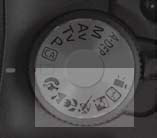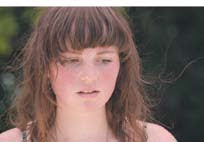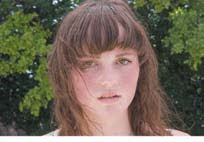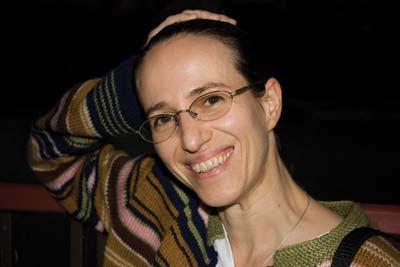How to use screen modes in canon eos 500d, t1i
Sunday, October 4, 2009
Using Scene Modes
Now you’ve seen how the T1i’s Full Auto mode works. Since Full Auto mode takes
care of all the critical decisions regarding camera settings, it’s an ideal mode for
snapshot shooting and for getting used to the camera. Before you go off shooting,
though, let’s take a quick look at some other auto features that you might find
useful while getting started.
On the Mode dial, you’ll see a bunch of little icons underneath the Full Auto option.
These are the T1i’s scene modes.

These options on the Mode dial are scene modes, which bias the camera’s decisions
under specific conditions so that it calculates more appropriate exposures
Scene modes are also fully automatic, but each one biases some of its decisions in
a certain way to make it more appropriate to particular types of shooting.
Portrait mode
Portrait mode is ideal for shooting—you guessed it!—portraits.
What makes a portrait different from any other type of shot? Typically,
in a portrait you want the background blurred out to bring more attention to
your subject. Portrait mode biases its exposure decisions to attempt to blur
the background.

In the upper image, I shot with deeper depth of field to reveal details in the
background. In the lower image, I shot with shallow depth of field to blur the
background out and bring more focus to the subject.

Landscape mode
Landscape mode can help your landscape shots because
it will choose settings that attempt to maximize the amount of your
scene that will be in focus. It’s basically the opposite of Portrait mode.
Close-up mode
Close-up shots of flowers or small objects (what is traditionally
referred to as macro photography) are made easier with Close-up
mode.
Sports mode
When shooting fast-moving subject matter such as moving
wildlife or a sporting event, opt for Sports mode. Sports mode biases the camera’s
exposure so that fast-moving objects will be sharp and clear.
When using Sports mode, make sure the center focus point is on your subject
when you press the shutter button halfway. Unlike other modes, you won’t
hear a beep when the camera has locked focus. Instead, the camera will begin
beeping continuously to indicate that it is now tracking your subject! Yes,
Sports mode uses the Rebel T1i’s Servo focus feature to track a moving object
and keep it in focus.
Press the shutter to take a shot. If you keep the shutter button held down, the
camera will continue to shoot.
Night Portrait mode
One of the biggest mistakes people make when
shooting with flash is that they assume a flash can light up an entire scene,
just as if it were daylight. But the flash on any camera has a limited range. It’s
usually enough to light up your subject but not your background, leaving you
with a subject that appears to be standing in the middle of a dark limbo.
Disabling Flash
mode Flash photography is not always allowed. Museums,
performances, and other public venues often prohibit flash photography.
Set the mode dial to Disabling Flash mode, and the T1i will never use its
flash.
When shooting without the flash, you may find that some of the numbers inside
the viewfinder blink. When this happens, the camera is informing you that light
is low, so you need to be extra careful to hold the camera steady. Also, be aware
that when the numbers are flashing, there’s a good chance that your resulting
image will be too dark.

At night, if you take a flash picture, you’ll usually end up with a well-exposed
subject on a background of complete black. This is because the range of the flash is
only about 10 feet. Objects beyond that will not be illuminated by the flash.










[get this widget]
Now you’ve seen how the T1i’s Full Auto mode works. Since Full Auto mode takes
care of all the critical decisions regarding camera settings, it’s an ideal mode for
snapshot shooting and for getting used to the camera. Before you go off shooting,
though, let’s take a quick look at some other auto features that you might find
useful while getting started.
On the Mode dial, you’ll see a bunch of little icons underneath the Full Auto option.
These are the T1i’s scene modes.

These options on the Mode dial are scene modes, which bias the camera’s decisions
under specific conditions so that it calculates more appropriate exposures
Scene modes are also fully automatic, but each one biases some of its decisions in
a certain way to make it more appropriate to particular types of shooting.
Portrait mode
Portrait mode is ideal for shooting—you guessed it!—portraits.
What makes a portrait different from any other type of shot? Typically,
in a portrait you want the background blurred out to bring more attention to
your subject. Portrait mode biases its exposure decisions to attempt to blur
the background.

In the upper image, I shot with deeper depth of field to reveal details in the
background. In the lower image, I shot with shallow depth of field to blur the
background out and bring more focus to the subject.

Landscape mode
Landscape mode can help your landscape shots because
it will choose settings that attempt to maximize the amount of your
scene that will be in focus. It’s basically the opposite of Portrait mode.
Close-up mode
Close-up shots of flowers or small objects (what is traditionally
referred to as macro photography) are made easier with Close-up
mode.
Sports mode
When shooting fast-moving subject matter such as moving
wildlife or a sporting event, opt for Sports mode. Sports mode biases the camera’s
exposure so that fast-moving objects will be sharp and clear.
When using Sports mode, make sure the center focus point is on your subject
when you press the shutter button halfway. Unlike other modes, you won’t
hear a beep when the camera has locked focus. Instead, the camera will begin
beeping continuously to indicate that it is now tracking your subject! Yes,
Sports mode uses the Rebel T1i’s Servo focus feature to track a moving object
and keep it in focus.
Press the shutter to take a shot. If you keep the shutter button held down, the
camera will continue to shoot.
Night Portrait mode
One of the biggest mistakes people make when
shooting with flash is that they assume a flash can light up an entire scene,
just as if it were daylight. But the flash on any camera has a limited range. It’s
usually enough to light up your subject but not your background, leaving you
with a subject that appears to be standing in the middle of a dark limbo.
Disabling Flash
mode Flash photography is not always allowed. Museums,
performances, and other public venues often prohibit flash photography.
Set the mode dial to Disabling Flash mode, and the T1i will never use its
flash.
When shooting without the flash, you may find that some of the numbers inside
the viewfinder blink. When this happens, the camera is informing you that light
is low, so you need to be extra careful to hold the camera steady. Also, be aware
that when the numbers are flashing, there’s a good chance that your resulting
image will be too dark.

At night, if you take a flash picture, you’ll usually end up with a well-exposed
subject on a background of complete black. This is because the range of the flash is
only about 10 feet. Objects beyond that will not be illuminated by the flash.










[get this widget]
0 Comments:
Powered by Blogger Tutorials




